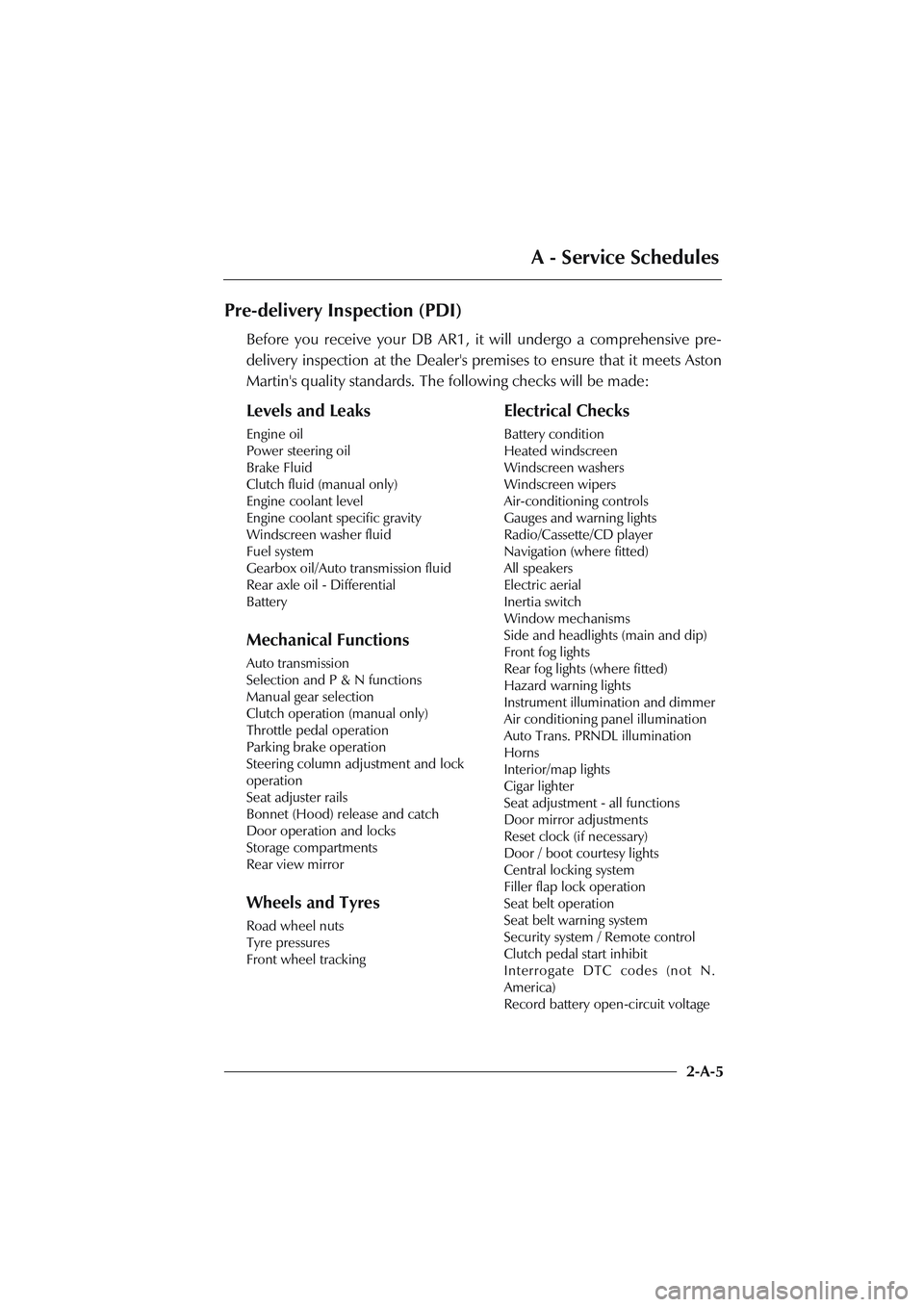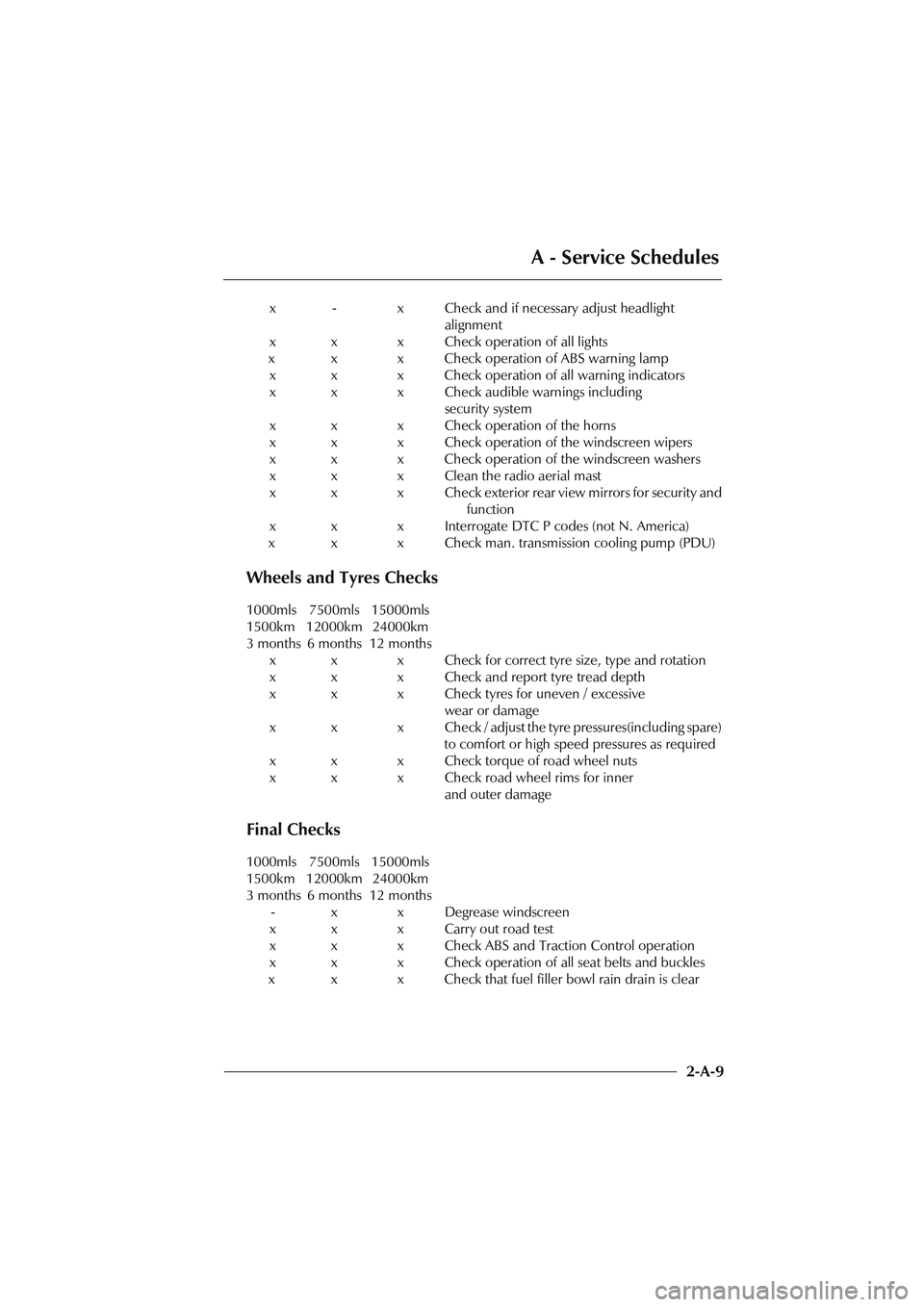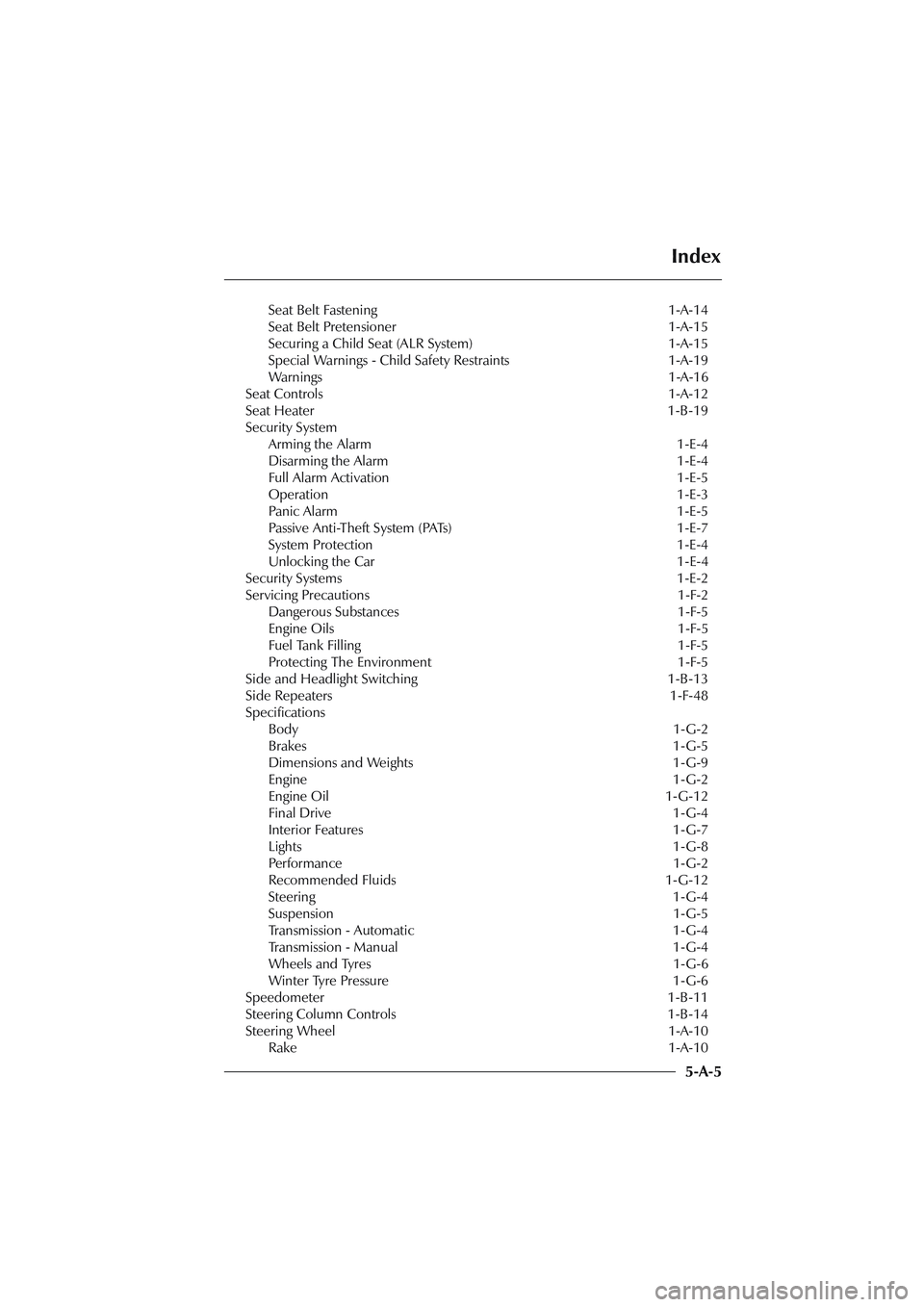warning lights ASTON MARTIN DB AR1 Q 2003 Owners Guide
[x] Cancel search | Manufacturer: ASTON MARTIN, Model Year: 2003, Model line: DB AR1 Q, Model: ASTON MARTIN DB AR1 Q 2003Pages: 279, PDF Size: 3.77 MB
Page 87 of 279

C - Driving
1-C-22
Brake Warning Indications During Driving
Your DB AR1 electronic control units continue to monitor correct operation
of the braking sub-systems while the vehicle is being driven. Two brake
warning lights are of particular importance.
The Anti Lock Braking (ABS) Warning Light
The ABS system is monitored for correct operation while the
ignition is switched on. If a fault is detected, the Anti-Lock
warning light will illuminate and the ABS system will be partly
or fully disabled.
The normal braking system will continue to function without anti-lock but
with full vacuum boosted braking to all road wheels being maintained. In
the event of an ABS fault, consult your Aston Martin Dealer immediately.
WARNING: If the ABS warning light illuminates, you should be aware that
wheels could lock during extreme braking or when braking on slippery surfaces.
Take additional care to avoid the danger of wheels locking.
The Brake System Warning Light
The braking system is continuously monitored for fluid level.
If only the brake warning light illuminates, it indicates that the
brake fluid has fallen below the acceptable level. It is essential
that the braking system is checked immediately, preferably
by an Aston Martin Dealer.
WARNING: If the brake warning light illuminates, you should
immediately be prepared for possible increased stopping distances
and possible partial failure of the braking system.
Page 138 of 279

F - Owner Maintenance
1-F-29 3. Raise the vehicle using a 'spectacle frame' type lifting device with a cradle
positioned under each front wheel as shown below.
Rear Suspended Tow
Caution: To prevent body damage ensure an adequate clearance is
maintained between the car body and (1) the ground and (2) the 'spectacle
frame' of the towing vehicle while your car is being towed.
1. Remove the ignition key from the ignition/steering lock.
2. Raise the vehicle using a 'spectacle frame' style lifting device where a
cradle is positioned under each rear wheel as indicated below.
Towing by Another Vehicle
WARNING: When the engine is stationary, there will be no power assistance to
the steering or brakes. Therefore be prepared for relatively heavy steering and
the need for greatly increased brake pedal pressure.
The vehicle may be towed short distances by another provided that a speed
of 48 km/h (30 mph) is not exceeded. Do not tow for more than 24km (15
miles). When being towed, the vehicles gear lever, or gear selector lever
(automatic transmission), must be in Neutral or position N with the ignition
key turned to position II to release the steering lock and to render the horn,
indicators and brake lights operational.
Page 145 of 279

F - Owner Maintenance
1-F-36
Electrical Start from Another Vehicle
If your DB AR1 will not start due to a discharged battery, it may be started
by connecting the battery from another vehicle to the discharged battery.
Before the vehicle is started in this way, ensure that the donor vehicle has
a 12 volt battery and negative (-), black earth terminal to ensure that the
correct battery polarity is maintained.
WARNING: If the voltage or earth of the donor vehicle is different or not known,
do not attempt starting in the way described.
1. Position the vehicles so that the connecting cable will reach between
the batteries. Ensure that the vehicles do not touch each other.
2. To lessen the risk of an electrical short circuit, remove rings, metal
watch bands and any other jewellery. Wear eye protection when
working near the battery. Turn off all electrical motors and ancillaries
in both vehicles. Switch off all lights except those needed to protect the
vehicles or illuminate the work area. Switch off the ignition and apply
the handbrake.
3. Lift out the boot floor panels to gain access to the battery.
4. Connect the red (+) cable between the red (+) positive terminal of the
two batteries.
5. Connect the black (-) cable between the black (-) negative terminals of
the two batteries.
6. Start the donor vehicle engine and run at about 1500 - 2000 rpm.
7. Start the engine. Allow the engine to run for some minutes until the flat
battery is partially charged. Switch off both vehicles.
Page 169 of 279

F - Owner Maintenance
1-F-60
Recommissioning After Storage
Provided that the car has been stored in accordance with the recommended
procedure, the following points only should require attention before using
the car on the road.
Check the tyre pressures, inflate if necessary and lower the car to the ground.
Fully charge and refit the battery. Reset the clock and electric windows.
Drain the engine sump and final drive unit, fit a new engine oil filter element,
then refill with the approved oils. Check the coolant level and if necessary
top up with the correct antifreeze/water solution.
Check all fluid levels and top-up as necessary. Fill the fuel tank
Caution: Starting the engine without sufficient lubrication can cause serious engine
damage. Take care to establish engine oil pressure as directed in the following steps
before allowing the engine to start.
Press and hold the accelerator hard to the floor (kickdown switch actuated).
This will temporarily inhibit the fuel injectors during cranking. Turn on the
ignition. Press and hold the starter button to crank the engine until normal
oil pressure is indicated on the oil pressure gauge. Release the starter button
and the accelerator pedal.
Start the engine normally and check that the oil pressure and ignition
warning lights go out as the engine starts indicating correct oil pressure and
battery charging. Raise the bonnet and check for leaks of fuel, oil and
coolant.
Finally, check the operation of all instruments, lights and accessories.
Page 190 of 279

2-A-5
A - Service Schedules
Pre-delivery Inspection (PDI)
Before you receive your DB AR1, it will undergo a comprehensive pre-
delivery inspection at the Dealer's premises to ensure that it meets Aston
Martin's quality standards. The following checks will be made:
Levels and Leaks
Engine oil
Power steering oil
Brake Fluid
Clutch fluid (manual only)
Engine coolant level
Engine coolant specific gravity
Windscreen washer fluid
Fuel system
Gearbox oil/Auto transmission fluid
Rear axle oil - Differential
Battery
Mechanical Functions
Auto transmission
Selection and P & N functions
Manual gear selection
Clutch operation (manual only)
Throttle pedal operation
Parking brake operation
Steering column adjustment and lock
operation
Seat adjuster rails
Bonnet (Hood) release and catch
Door operation and locks
Storage compartments
Rear view mirror
Wheels and Tyres
Road wheel nuts
Tyre pressures
Front wheel tracking
Electrical Checks
Battery condition
Heated windscreen
Windscreen washers
Windscreen wipers
Air-conditioning controls
Gauges and warning lights
Radio/Cassette/CD player
Navigation (where fitted)
All speakers
Electric aerial
Inertia switch
Window mechanisms
Side and headlights (main and dip)
Front fog lights
Rear fog lights (where fitted)
Hazard warning lights
Instrument illumination and dimmer
Air conditioning panel illumination
Auto Trans. PRNDL illumination
Horns
Interior/map lights
Cigar lighter
Seat adjustment - all functions
Door mirror adjustments
Reset clock (if necessary)
Door / boot courtesy lights
Central locking system
Filler flap lock operation
Seat belt operation
Seat belt warning system
Security system / Remote control
Clutch pedal start inhibit
Interrogate DTC codes (not N.
America)
Record battery open-circuit voltage
Page 194 of 279

2-A-9
A - Service Schedules
x - x Check and if necessary adjust headlight
alignment
x x x Check operation of all lights
x x x Check operation of ABS warning lamp
x x x Check operation of all warning indicators
x x x Check audible warnings including
security system
x x x Check operation of the horns
x x x Check operation of the windscreen wipers
x x x Check operation of the windscreen washers
x x x Clean the radio aerial mast
x x x Check exterior rear view mirrors for security and
function
x x x Interrogate DTC P codes (not N. America)
x x x Check man. transmission cooling pump (PDU)
Wheels and Tyres Checks
1000mls 7500mls 15000mls
1500km 12000km 24000km
3 months 6 months 12 months
x x x Check for correct tyre size, type and rotation
x x x Check and report tyre tread depth
x x x Check tyres for uneven / excessive
wear or damage
x x x Check / adjust the tyre pressures(including spare)
to comfort or high speed pressures as required
x x x Check torque of road wheel nuts
x x x Check road wheel rims for inner
and outer damage
Final Checks
1000mls 7500mls 15000mls
1500km 12000km 24000km
3 months 6 months 12 months
- x x Degrease windscreen
x x x Carry out road test
x x x Check ABS and Traction Control operation
x x x Check operation of all seat belts and buckles
x x x Check that fuel filler bowl rain drain is clear
Page 273 of 279

Index
5-A-2
C
Care and Maintenance of Seat Belts 1-F-57
Catalytic Converters 1-C-4
Child Safety Seats
Child Seats and Passenger Airbags 1-A-20, 1-A-21
Warnings 1-A-19
Clock 1-B-17
Column Switchgear
Left Hand Stalk 1-B-12
Right Hand Stalk 1-B-14
Console Mounted Controls 1-B-16
D
Door Edge Lights 1-F-52
Door Locks 1-A-5
Door Sealing 1-A-5
Driving in Wet Conditions 1-C-9
E
Electric Window Reset Procedure 1-F-52
Electrics
Battery 1-F-30
Engine Bay 1-F-6
Engine Coolant Temperature Gauge 1-B-11
Engine Immobiliser 1-A-4
F
Fluid Level Checks 1-F-4
Brake Fluid Reservoir 1-F-11
Clutch Hydraulic Fluid Reservoir 1-F-9
Engine Oil Level 1-F-7
Power Steering Reservoir 1-F-10
Footbrake 1-C-19
Front Indicator Lights / Front Parking Lights 1-F-47
Front Interior Lights 1-F-51
Fuel 1-C-2
Fuel Cut-Off Switch 1-C-8
Fuel Filler Cap 1-C-3
Fuel Filling 1-C-3
Fuel Gauge 1-B-10
Fuse Boxes 1-F-38
Fuse Lists - Right Hand Drive 1-F-39
Page 274 of 279

Index
5-A-3
G
Gear Changing - Manual Transmission 1-C-10
Gear Changing - Touchtronic Transmission 1-C-11
Gearbox Functions 1-C-16
General Information Forward-vii
Maintenance and Servicing Forward-viii
Safety Information Forward-vii
Vehicle Identification Forward-ix
Glossary of Terms Forward-xii
H
Handbrake 1-C-23
Hazard Warning Lights 1-B-19
Headlamp Ventilation 1-F-53
Headlight Dipped Beam Bulb Replacement 1-F-44
Headlight Flashing 1-B-13
Headlight Main Beam Bulb Replacement 1-F-43
I
Ignition Lock 1-C-5
Information/Warning Lights and Instruments 1-B-4
Interior Door Handles and Locks 1-A-6
Interior Lights 1-B-24
Interior Mirror 1-A-14
Interior Storage 1-A-22
J
Jacking and Wheel Changing 1-F-22
K
Kickdown 1-C-16
L
Lighting and Screen Heating Switches 1-B-18
Location of Components Forward-xii
Locking the DB AR1 1-A-4
Locking the Doors when Inside The Car 1-A-6
Lockup 1-C-16
Page 275 of 279

Index
5-A-4
M
Main and Dipped Beam Switching 1-B-13
Maximum Engine Speed 1-C-9
Mirrors
Interior Mirror 1-A-13
N
Number Plate Lights 1-F-50
O
On Board Headlight Aiming 1-F-45
Owner Maintenance 1-F-2
Electronic Fuel Injection 1-F-2
Emission Warranty 1-F-3
Engine Compartment Covers 1-F-3
Parts and Lubricants 1-F-3
P
Passive Anti-Theft System 1-E-7
PATs Status 1-E-8
Starting the Engine 1-E-7
PATs Status 1-E-8
R
Rain Cover 1-A-7
Rear Interior Quarter Lights 1-F-51
Rear Lights 1-F-48, 1-F-49
Recommissioning After Storage 1-F-60
Regular Checks Forward-xi
Each Day Forward-xi
Monthly Forward-xii
Weekly Forward-xi
Reporting Safety Defects - ROW Forward-x
Running-In 1-C-9
S
Seat Belt Fastening 1-A-14
Seat Belt Pretensioner 1-A-14
Seat Belt Warnings 1-A-16
Seat Belts
Automatic Locking Retractors (ALR) 1-A-15
Care and Maintenance 1-F-57
Child Seat Removal (ALR System) 1-A-16
Page 276 of 279

Index
5-A-5
Seat Belt Fastening 1-A-14
Seat Belt Pretensioner 1-A-15
Securing a Child Seat (ALR System) 1-A-15
Special Warnings - Child Safety Restraints 1-A-19
Warnings 1-A-16
Seat Controls 1-A-12
Seat Heater 1-B-19
Security System
Arming the Alarm 1-E-4
Disarming the Alarm 1-E-4
Full Alarm Activation 1-E-5
Operation 1-E-3
Panic Alarm 1-E-5
Passive Anti-Theft System (PATs) 1-E-7
System Protection 1-E-4
Unlocking the Car 1-E-4
Security Systems 1-E-2
Servicing Precautions 1-F-2
Dangerous Substances 1-F-5
Engine Oils 1-F-5
Fuel Tank Filling 1-F-5
Protecting The Environment 1-F-5
Side and Headlight Switching 1-B-13
Side Repeaters 1-F-48
Specifications
Body 1-G-2
Brakes 1-G-5
Dimensions and Weights 1-G-9
Engine 1-G-2
Engine Oil 1-G-12
Final Drive 1-G-4
Interior Features 1-G-7
Lights 1-G-8
Performance 1-G-2
Recommended Fluids 1-G-12
Steering 1-G-4
Suspension 1-G-5
Transmission - Automatic 1-G-4
Transmission - Manual 1-G-4
Wheels and Tyres 1-G-6
Winter Tyre Pressure 1-G-6
Speedometer 1-B-11
Steering Column Controls 1-B-14
Steering Wheel 1-A-10
Rake 1-A-10